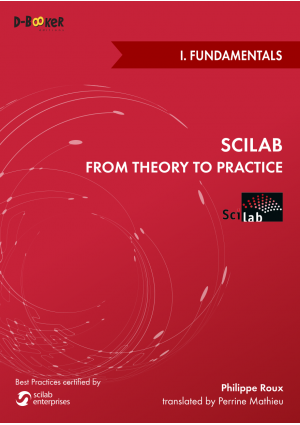



Black and white inprint
Also available on Barnes&Noble, Amazon US or UK and other main online bookshops !
Version française disponible ici.
Scilab is a free and open source numerical computation software meant for the theoretician as well as the engineer. It possesses a high level computer language that is well adapted to mathematical notation, as well as complementary modules targeted at scientific applications. These applications include signal and image processing, statistical analysis, mechanical simulations, fluid dynamics, numerical optimization, modeling and simulation of hybrid dynamic systems, etc. Il is available under GNU/Linux, Mac OS X and Windows XP/Vista/7/8/10. (See also Scilab's Official Website.)
This book provides a comprehensive, hands-on introduction to the powerful computing environment of Scilab.
Scilab has greatly changed since 2010, consequently a large portion of the existing documentation is now obsolete. This book is based on the most recent version of Scilab (5.5) and we have put a great deal of care into communicating the best practices relevant to the current software.
Number of pages: approx. 410
What You Will Learn
This book will teach you all the basic Scilab concepts you need for computing, analyzing and visualizing data, for developing algorithms, and creating models. Based on the latest versions of Scilab, it focuses on the most recent recommended practices. It offers a lot of advice or words of caution to help you take full advantage of Scilab's capabilities and to create your own projects efficiently.
Best practices have been certified by Dr. Claude Gomez, co-founder and advisor of Scilab Enterprises.
After performing a quick overview of the software, three parts will successively deal with computing, programming and creating plots. The first one shows you how to perform and optimize all the mathematical calculations that an engineer may come across. The second one examines how to go beyond the simple calculations and study complex systems with scripting and interface building. The last one gives you a thorough description of Scilab's numerous graphics capabilities.
Who This Book Is For
This book is aimed at an audience of new users as well as at people familiar with Scilab who wish to update or build on their current knowledge. It assumes the reader feels comfortable using a computer and possesses a basic knowledge of what computer programming is. Some technical notions as well as physics or mathematics knowledge may be required in some sections.
Even if you have mastered Scilab, you may use this book as a quick reference.
Target audience: Engineers, Engineering Students
Prerequisites: Mathematical and Computational concepts
Book level: Intermediate / Advanced
The book is organized in relatively independent modules, which means you may acquire only the part you need as an e-book. Be aware that you cannot take full advantage of Scilab's graphics capabilities if you do not have a basic knowledge of its calculating or programming tools. The sequence of the parts is important for beginners.
> Interview of Claude Gomez, co-founder and advisor of Scilab Enterprises
| Beginning of Chapter 21: Three-dimensionalPlots | Télécharger cet extrait | |
| Beginning of Chapter 14: Scripts | Télécharger cet extrait | |
| Beginning of Chapter 9: Matrices | Télécharger cet extrait | |
| Chapter 6: Downloading and Installing Scilab | Télécharger cet extrait | |
| Chapter 5: Finding Information on Scilab | Télécharger cet extrait | |
| Chapter 4: Inputs/Outputs | Télécharger cet extrait | |
| Chapter 3: The Graphical Interface | Télécharger cet extrait | |
| Chapter 2: The Console | Télécharger cet extrait | |
| Chapter 1: Preview of Scilab | Télécharger cet extrait | |
| Table Of Contents | Télécharger cet extrait |
Getting Started
1. Preview of Scilab
2. The Console
3. The Graphical Interface
4. Inputs/Outputs
5. Finding Information on Scilab
6. Downloading and Installing Scilab
Computing
7. Numbers and First Calculations
8. Variables, Constants and Types
9. Matrices
10. Booleans
11. Character Strings and Text Files
12. Other Common Types
13. Calculation Examples
Programming
14. Scripts
15. Control Flow Statements
16. Functions
17. Advanced Programming
18. Example: Programming a Sudoku Game
Creating Plots
19. Graphics Entities and Windows
20. Two-dimensional Plot
21. Three-dimensional Plots
22. Other Two-dimensional Geometrical Elements
23. To Go Even Further
24. Two Case Studies: a Pendulum and Comet Orbit
| GIF Animations Gallery | Find here the GIF animations for the book. |
Consulter |
| Videos Gallery | Find here the videos for the book. |
Consulter |
| Color Images Gallery | This Gallery is aimed at readers of the black & white printed version, so that they can see in color the most important images taken from the part of the book called Creating Plots. |
Consulter |
| Source Code of examples | Consulter |